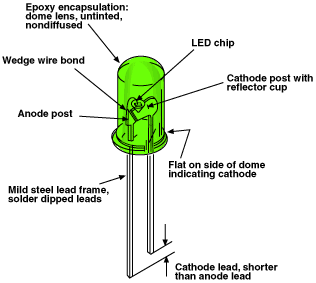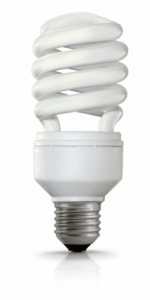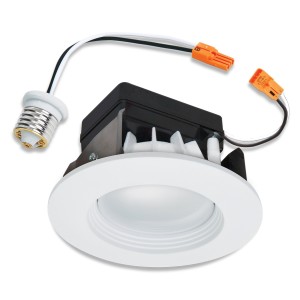You might be surprised how much energy you can save on lighting! Lights can use quite a bit of power, especially inefficient, high wattage bulbs like halogen and incandescent. Also, even though these bulbs are cheaper, they burn out much faster and emit more heat.
So let’s look at the better alternatives.
 LED (Light-Emitting Diode)
LED (Light-Emitting Diode)
This technology was originally used for electronic devices, but now has been adapted to a much wider range of applications. It has very few disadvantages, other than the relatively high price, which is more than made up for in efficiency and durability.
LEDs used for interior lighting have the following advantages:
1. High lumens per watt (high energy efficiency)
2. Fast on/off time, and no problems with cycling (turning on and off frequently), and dimming
3. Cool light (emits very little heat)
4. Long lifetime. This may be the most relevant factor, even more than the high energy efficiency. Estimates put LED lifetimes at 25,000-50,000 hours, whereas incandescents are around 1,000-2,000, and fluorescent are 10,000-15,000. The price doesn’t seem so bad, after looking at those numbers.
 CFL (Compact Fluorescent Lamp)
CFL (Compact Fluorescent Lamp)
Fluorescent lights have good bang for your buck. Compared to incandescent and halogen, they have much higher efficiency and longer lifetime. This is why they are the most widely used form of efficient interior lighting today. But they don’t measure up to LEDs. Not even close, actually.
CFLs disadvantages vs LEDs
1. About 35% less lumens per watt, on average (varies with manufacturer)
2. Less than 1/2 the estimated lifespan (and more ways the lifespan can be shortened)
3. Long on/off time, and lifespan is shortened by cycling (frequently turning on and off).
4. Dimming: Standard CFLs do not work with dimmers, and it will shorten their lifetime and void their warranty. There are dimmable CFLs available, however.
5. Failure: CFLs have more ways they can fail. Failures involving the electronic ballast can occur before the estimated lifetime.
6. Hazardous: CFLs contain mercury! This makes them much more difficult to dispose of and/or recycle. Also, some models are known to produce significant amounts of smoke and heat upon failure.
*IMPORTANT* Need to knows about recessed ceiling light fixtures
IC (insulation contact) rated cans
If you’re using recessed ceiling light fixtures, you should be aware that they can cause a significant energy loss via building leakage, because insulation cannot be placed over them. Recessed cans are inherently very leaky, and they are a direct link between the attic and the interior. This is not air you want to be breathing regularly. So, we strongly recommend that you choose IC rated recessed cans. Although these are just as leaky as non-IC rated cans, you can seal them directly from the attic side or interior without having to build a sealed box around the can in the attic as one needs to do with non-IC rated cans.
Alternatives
Some LEDs come with built-in trim and weatherstripping, that can be mounted into any recessed can. This helps with the leakage of the home a great deal, although you still cannot insulate over them if you’re not using an IC rated can (LEDs, although cooler, still emit heat, and are still considered a fire hazard if there is insulation touching non IC rated cans).
 Here is a good quality LED ceiling fixture, made by CREE (image left).
Here is a good quality LED ceiling fixture, made by CREE (image left).
Also, if you want to fully insulate your attic, but don’t want to switch to IC rated cans, you will need to purchase or construct “recessed light covers.” These are airtight domes or boxes, often made of rigid foam, that cover recessed cans in your attic, leaving at least 2″ of airspace on all sides.
Conclusion
1. Switch all your lights to LED as soon as possible. This may seem like overkill, especially for lights you don’t use often, but it will be worth it. LEDs will pay off their initial price many times over, in energy savings and durability.
2. If you want attic insulation, get IC rated cans for your ceiling fixtures, or recessed light covers for your existing non-IC rated cans.
3. Support newer, better technology designed for the long-term. Don’t buy incandescent or halogen lights.
[dropshadowbox align=”none” effect=”lifted-both” width=”640px” height=”” background_color=”#ffffff” border_width=”1″ border_color=”#dddddd” ]For more information, call (925) 363-4498 or e-mail info@epbuilders.com to speak to a technician, or schedule an energy audit.[/dropshadowbox]

Speak Your Mind